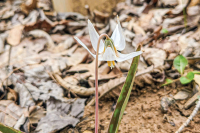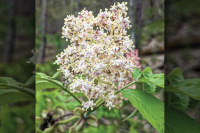Notes from a plant nerd: What a Lark
 Dwarf larkspur (Delphinium tricorne). Adam Bigelow photo
Dwarf larkspur (Delphinium tricorne). Adam Bigelow photo
I wear a few different hats in my world. A big straw hat for working in the garden or walking out in the sun. Wool caps and toboggans for the colder mornings of spring. Party hats for the celebrations. I’ve even been known to wear a tricorne hat when visiting Colonial Williamsburg as a kid.
One of my favorite hats to wear is as an environmental educator teaching people of all ages about the beauty and interconnected diversity of plants and wildflowers. I get to lead merry, carefree adventures frolicking among the wildflowers on weekly escapades.
And I love my work.
Among my favorite springtime blooms is that of the dwarf larkspur (Delphinium tricorne) whose numerous purple blooms fill the hillside above my home and are lining some of the roadsides along the Blue Ridge Parkway right now. These small and stunning flower are filled with stories of mythology and ecological relationships, some of my favorite parts of teaching plants.
The Botanical Latin name begins the story of the larkspur flowers. Delphinium is a reference to the Greek word from where we also get the word dolphin, Delphos, which means womb. I used to not understand the reference to dolphins in this beautiful flower of the mountains until I noticed in one of my photos that the unopened flower buds look exactly like a dolphin, or possibly their relative the orca.
Once the flowers open, they take on the look of an old, grizzled forest wizard’s hat as their petals. These are called sepals, modified leaves that protect the unopened flower bud and then offer the same attractive benefit as flower petals. These beautiful flowers, ranging from blue to purple to white, often showing all of those colors at once, are borne on a raceme or stalk above the geranium-like leaves.
Related Items
The five showy sepals are arranged around the central flower and curve backward to show the pollinating insects and hummingbirds where to find the nectar. The top sepal forms into a long curving tube called a spur, which is where the sweet nectar is contained. Long-tongued pollinators must reach deeply into this flower to get their sugary reward and are depositing and picking up pollen as they do.
Once pollinated, the ripening seed pods take on the shape of a tricorne hat with three corners arranged radially above the central stem. The small, black seeds are released when the seed heads split open and are easily collected and for sowing in your shade garden.
Dwarf larkspur leaves are toxic to most mammals, so they are rarely eaten by herbivores like deer, or even your four-legged companions. Make sure you don’t eat them, as all parts of the plant are toxic to Humans. Delphiniums do offer host plant support for the flower eating caterpillars of the darker-spotted straw moth (Heliothis phloxiphaga) which also eat the flowers of phlox (Phlox spp.); as the moth’s Latin name suggests, the suffix “-phage” means to eat.
I see a beautiful stand of Delphiniums frolicking in the waves of your forest garden, as if foretold by the Oracle of Delphi of Greek Mythology. Or rather, the dolphin oracle. Go dance and play in the waves of springtime, my friends. And be careful not to crush the many beautiful flowers you see along the way, or you may just suffer the gentle wrath of the goddesses of old.
(Adam Bigelow lives in Cullowhee. He leads weekly wildflower walks most Fridays and offers consultations and private group tours through Bigelow’s Botanical Excursions. This email address is being protected from spambots. You need JavaScript enabled to view it..)













